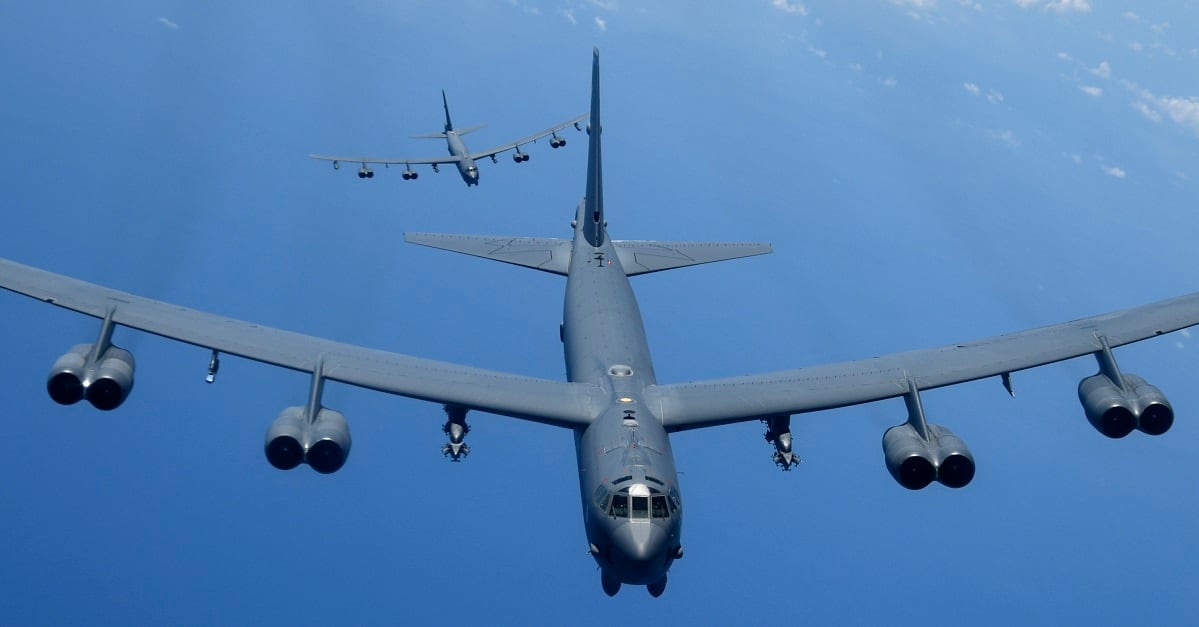U.S. Air Force B-52 Stratofortress bombers are flying “simultaneous training flights” over Europe and the Pacific Ocean this month.
The sorties are a coordinated effort by European Command, Indo-Pacific Command and Strategic Command, U.S. officials said in a press release issued to “promote transparency and communicate our intentions.”
“This Bomber Task Force rotation is the largest deployment of a single bomber platform to Europe since we had 17 bombers on the ramp at RAF Fairford in 2003 for Operation Iraqi Freedom,” Maj. Tristan Hinderliter, a U.S. Air Forces Europe spokesman, said in an email. “I make the distinction of ‘a single bomber platform’ because in summer 2017 we briefly had 2x B-1s, 2x B-2s and 2x B-52s at Fairford.”
On Monday, four B-52s flew theater familiarization flights from RAF Fairford, England, which serves as USAFE’s forward operating location for bombers. A total of six bombers and 400 airmen are at RAF Fairford for this rotation.
The B-52s flew over the Norwegian Sea, the Baltic Sea, Estonia, the Mediterranean Sea and Greece.
“The six B-52s and more than 400 airmen deployed to RAF Fairford allow us to test and evaluate the ability to rapidly provide a larger force to a combatant commander,” Maj. Andrew Caulk, 2nd Bomb Wing public affairs chief, told Air Force Times. “The data we gather from this deployment will help to identify potential shortfalls and improve processes for future operations.”
The bombers also flew to Greece and were refueled by a KC-135 Stratotanker en route. In Estonia, a B-52 conducted training with NATO joint terminal attack controllers on the ground.
The bombers were deployed to EUCOM’s area of responsibility from the 2nd Bomb Wing, Barksdale Air Force Base, Louisiana. The pilots, crews and maintenance personnel arrived in theater March 14-15.
Russian state news agency Tass reported that a U.S. B-52 bomber flew over the Baltic Sea Friday with its transponder on, but remained more than 95 miles from Russian territorial waters.
“The plane did not approach Russia’s border closer than 150 kilometers and turned around immediately after Russian air defense systems on combat duty tracked it,” the Russian Defense Ministry said in a statement.
The last time a B-52 was spotted over the Baltic Sea by Russian forces was in 2017, Tass reported.
U.S. Air Forces Pacific also launched B-52 bombers from Andersen Air Force Base, Guam, Monday, to conduct theater familiarization in the Indo-Pacific region.
The bombers flew north from Andersen AFB to an area east of the Kamchatka Peninsula, in Russia’s far east, before returning to base.
The B-52s at Andersen AFB are deployed from the 5th Bomb Wing out of Minot AFB, North Dakota, in support of the continuous bomber presence mission.
B-52 bombers also flew a mission over contested islands in the South China Sea on March 4, and another flight occurred Wednesday, March 13.
RELATED

Since 2004, the U.S. has rotated B-1, B-52 and B-2 long-range bombers to Guam for training flights in Asia.
The March 6 flight came just three days after U.S. Secretary of State Mike Pompeo visited the Philippines and said the U.S. is committed to ensuring the South China Sea remains open to all kinds of navigation and that “China does not pose a threat” of closing disputed sea lanes.
Pompeo said that the U.S. military will come to the Philippines’ aid if its aircraft or ships are attacked in the South China Sea, the first such public assurance in recent memory, according to the Associated Press.
Correction: This article has been corrected to reflect the fact that B-52 Stratofortress bombers flew out of Andersen AFB, Guam, on Monday, March 18, in addition to the flights that were conducted on March 4 and March 13.
Kyle Rempfer was an editor and reporter who has covered combat operations, criminal cases, foreign military assistance and training accidents. Before entering journalism, Kyle served in U.S. Air Force Special Tactics and deployed in 2014 to Paktika Province, Afghanistan, and Baghdad, Iraq.





